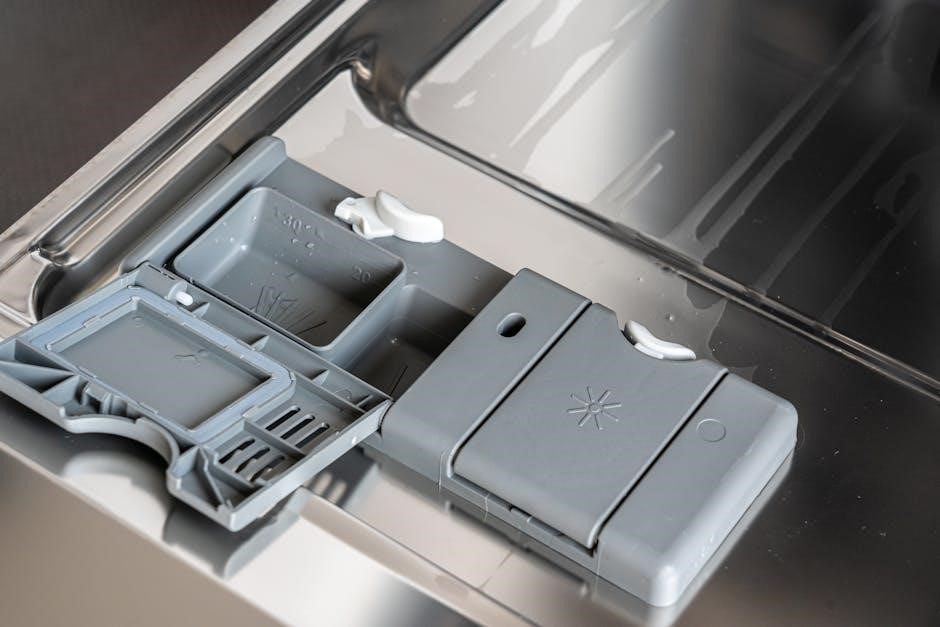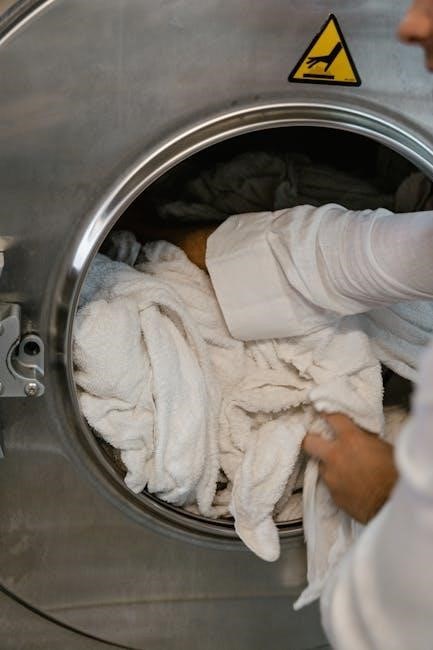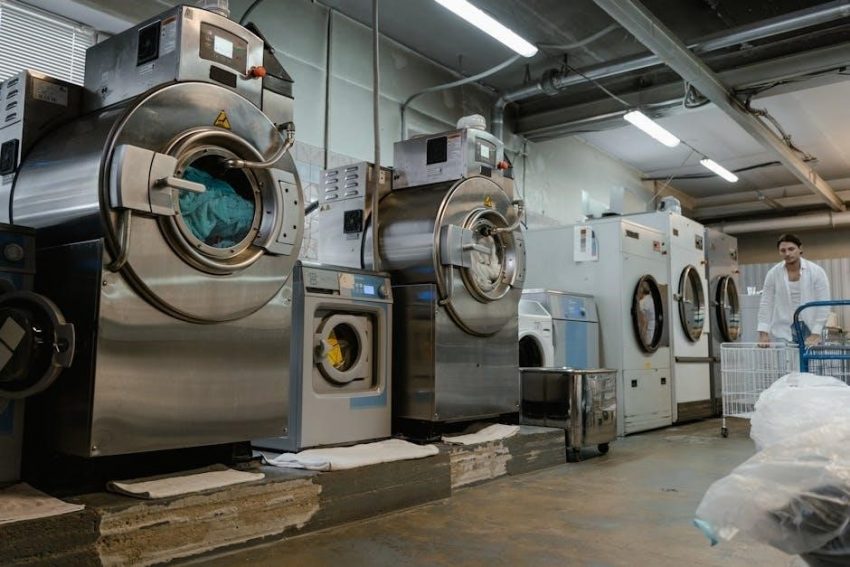Common Issues with GE Washing Machines
GE washing machines often face issues like not spinning, loud noises, poor drainage, or excessive vibration. These problems can typically be resolved by checking water supply hoses, ensuring proper balance, and cleaning drain filters. Regular maintenance and troubleshooting steps, such as resetting the machine or inspecting electrical connections, can prevent major repairs. Always refer to the user manual or official GE support resources for specific guidance.
Washer Won’t Spin
If your GE washing machine isn’t spinning, it could be due to an unbalanced load, power issues, or problems with the lid lock or motor. Check if the washer is properly plugged in and the outlet works. Ensure the load is balanced and the lid is closed securely. If the issue persists, inspect the belt, pulley, or motor for damage. Resetting the machine or checking error codes may also resolve the problem. If none of these steps work, contact a professional technician.
Washer Making Loud Noise
A loud noise from your GE washing machine could indicate an unbalanced load, worn-out bearings, or loose parts. Ensure the machine is level and the load is evenly distributed. Check for foreign objects like coins or zippers in the drum. Inspect the tub bearings and replace them if damaged. If the noise persists, verify the drain pump filter for blockages. Resetting the washer or running a diagnostic mode may also help identify the issue. Contact a technician if the problem remains unresolved.
Washer Won’t Drain
If your GE washing machine won’t drain, check the drain hose for kinks, blockages, or improper installation. Ensure the drain pump filter is clean, as debris like lint or coins can clog it. Verify the water supply hoses are securely connected and not restricted. If the issue persists, inspect the drain pump for damage or malfunction. Resetting the washer or running a diagnostic mode may also resolve the problem. If none of these steps work, contact a professional for further assistance.
Washer Vibrating or Shaking
If your GE washing machine is vibrating or shaking excessively, check the load balance and redistribute clothes if uneven. Ensure the machine is properly leveled and installed on a stable surface. Verify that all feet are securely tightened and consider using anti-vibration pads. If the issue persists, inspect for loose parts or worn-out shock absorbers. Cleaning the drain pump filter or checking for blockages may also help. If vibrations continue, consult a professional for further evaluation and repairs.

Diagnostic Modes and Error Codes
GE washing machines feature diagnostic modes to identify issues through specific error codes. These codes, like “E1” or “E2,” indicate problems such as sensor malfunctions or drainage issues. Accessing diagnostic mode often requires pressing and holding certain buttons, providing insights into the machine’s status. While some errors can be resolved with simple fixes, others may require professional intervention. Always consult the user manual or official GE resources for accurate interpretations and solutions.
Accessing Diagnostic Mode
To access diagnostic mode on a GE washing machine, press and hold the Detergent Dispense and Select buttons simultaneously for three seconds. This activates the diagnostic test, which displays error codes or signals through LED lights. The machine will perform a series of tests, including filling, washing, and spinning, to identify issues. Refer to your user manual for specific button combinations, as they may vary by model. This mode helps pinpoint problems efficiently for targeted troubleshooting.
Understanding Error Codes
GE washing machines use specific error codes to indicate issues. Codes like E1, E2, or E3 signal problems such as water supply errors, temperature issues, or imbalance detection. These codes help identify the root cause of malfunctions. Refer to your user manual or GE’s official resources to decode the meaning of each error. Once identified, follow the recommended troubleshooting steps or contact a professional for assistance. This feature streamlines diagnostics, making repairs more efficient and targeted.

Step-by-Step Troubleshooting Guides
Start by checking water supply hoses for blockages and ensuring proper drainage. Next, redistribute laundry loads for balance and reset the machine if necessary. Follow manual instructions for specific issues to resolve problems effectively and safely.
Checking Water Supply and Drainage
Ensure water supply hoses are securely connected and not kinked or clogged. Check the drain hose for proper installation and clearance. Verify the water inlet valve screens are clean, as debris can restrict water flow. If issues persist, inspect the drain pump filter for blockages and clean it if necessary. Always turn off the water supply before performing any manual checks or repairs.
Inspecting and Replacing Parts
Regularly inspect belts, pulleys, and hoses for wear or damage. Check the drain pump for blockages and clean it if necessary. If the tub bearing is faulty, it may cause loud noises and require replacement. Ensure all parts are properly aligned and securely fastened. Consult your GE manual for specific instructions on replacing components. If unsure, contact a professional technician to avoid further damage or safety risks. Always use genuine GE parts for reliability.

Preventive Maintenance Tips
Regularly clean the washer interior, check hoses for kinks, and ensure balanced loads. Leave the lid open after use and run cleaning cycles to maintain efficiency.
Cleaning the Washer Regularly
Regular cleaning is essential for maintaining your GE washing machine’s efficiency and preventing odors. Start by leaving the lid open after use to allow the interior to dry. Wipe the gasket with vinegar to remove mold and mildew. Clean the detergent dispenser by rinsing it under water. Run a cleaning cycle or a hot water cycle with vinegar or a washing machine cleaner to remove built-up detergent and debris. Additionally, check and clean the drain pump filter to ensure proper drainage. For balanced operation, ensure the washer is level and adjust the legs if necessary. Promptly removing wet clothes after washing helps prevent mildew. Consider using products like OxiClean or Affresh for deeper cleaning. Inspect hoses for kinks or cracks and replace them if needed. Finally, consult GE’s website for model-specific cleaning recommendations. By following these steps, you can keep your washing machine clean, efficient, and odor-free, extending its lifespan and ensuring fresh-smelling clothes.
Ensuring Proper Installation
Proper installation is crucial for optimal performance and safety. Start by ensuring the washing machine is level to prevent vibrations and noise. Check the water supply lines for leaks and kinks, and secure them tightly. Verify that the drainage setup is correct, with the drain hose properly positioned and free of obstructions. Ensure the power supply is stable and meets the machine’s requirements. Tighten all connections, including the lid, to avoid leaks. Finally, consult the installation manual for model-specific instructions and run a test cycle to confirm everything functions correctly.

GE Official Support and Resources
GE Appliances offers comprehensive support through online manuals, repair guides, and customer service. Visit their official website for troubleshooting resources and contact information to address your needs effectively.
GE Appliance Service Contact Information
For assistance with your GE washing machine, contact their customer service at 1-800-GECares (1-800-432-2737). Service is available Monday-Friday from 8 a.m. to 8 p.m. ET. You can also schedule service online or use their live chat feature for quick support. Visit their official website for more details and resources to address your appliance needs effectively.
Online Manuals and Repair Guides
GE Appliances provides comprehensive online manuals and repair guides for troubleshooting washing machines. Visit their official website to access detailed troubleshooting guides, exploded diagrams, and repair instructions. These resources help identify common issues and provide step-by-step solutions. Additionally, video tutorials and parts lists are available to assist with DIY repairs. Users can search by model number to find specific guidance, ensuring accurate and effective troubleshooting for their GE washing machine.

Advanced Troubleshooting Techniques
Advanced troubleshooting involves using diagnostic modes, error codes, and tools like multimeters to identify issues. Resetting the washer motor or checking electrical connections can often resolve problems.
Using Multimeter for Electrical Checks
A multimeter is essential for diagnosing electrical issues in GE washing machines. It measures voltage, current, and resistance, helping identify faulty components like switches or sensors. Ensure the machine is unplugged before testing. Check connections between the control board and motor for continuity. If readings are abnormal, replace the faulty part. Always refer to the user manual for specific electrical diagrams and safety guidelines to avoid accidents during testing.
Resetting the Washer Motor
Resetting the washer motor can resolve issues like mid-cycle stopping or failure to start. Unplug the machine, wait 30 minutes, then plug it back in. This resets internal controls. If the motor still malfunctions, check for error codes or imbalanced loads. Ensure the washer is on a level surface and properly installed. Resetting should restore normal operation, but if problems persist, consult the manual or contact GE support for further assistance;

Frequently Asked Questions
Address common concerns such as leaks, noise, or failure to start. These FAQs provide solutions and troubleshooting tips to resolve issues quickly and effectively.
Why Does My Washer Leak Water?
A leaking GE washer can be caused by loose or damaged water inlet hoses, a faulty gasket, or a clogged drain pump filter. Check the connections and ensure they are secure. Inspect the gasket for signs of wear or damage and replace it if necessary. Regularly cleaning the drain filter can prevent blockages that lead to leaks. For persistent issues, consult the user manual or contact GE support for assistance.
How to Fix a Washer That Won’t Start
If your GE washer won’t start, ensure it is properly plugged in and the outlet has power. Check that the lid is closed securely and the start button is functioning; Verify that the water supply valves are fully open. If the issue persists, unplug the washer, wait 30 seconds, and plug it back in to reset the system. Consult the user manual for specific reset instructions or contact GE support for further assistance if needed.
Resolving common GE washing machine issues often involves simple troubleshooting steps, such as checking power connections, ensuring proper water supply, and cleaning filters. Regular maintenance, like balancing loads and running cleaning cycles, can prevent many problems. For complex issues, accessing diagnostic modes or consulting official manuals and support resources is essential. By addressing problems early and utilizing available tools, you can extend the life of your washer and maintain optimal performance effectively.
